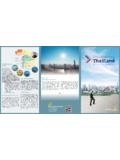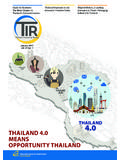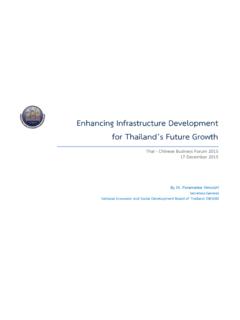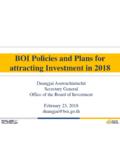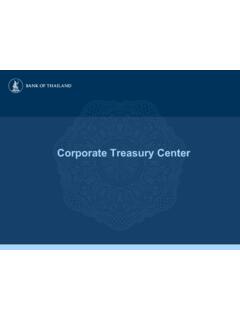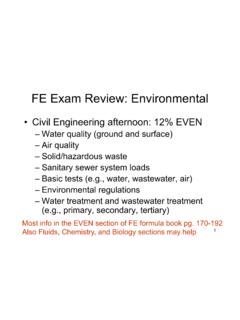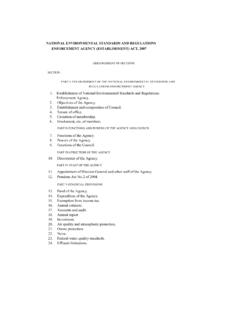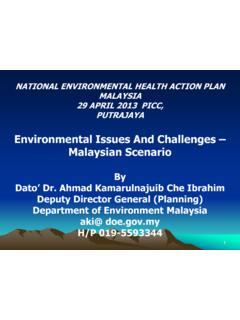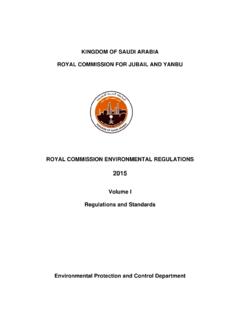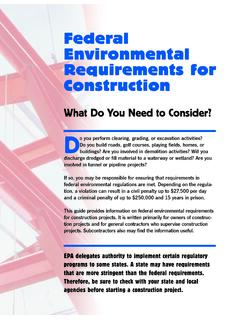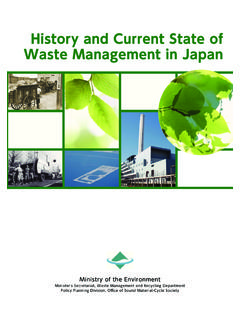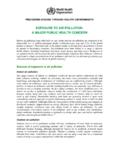Transcription of THAILAND BOARD OF INVESTMENT GUIDE ON …
1 THAILAND BOARD OF INVESTMENT GUIDE ON environmental REGULATIONS 12/19/2014 2 Table of Contents I. The Environment in THAILAND .. 4 II. Overview of EIA Proceedings .. 5 A. environmental Impact Assessment (EIA) .. 10 B. environmental Health Impact Assessment (EHIA) .. 29 C. Comparison Between an EIA and an E/HIA .. 36 D. Initial environmental Examination (IEE) .. 36 E. environmental Safety Assessment (ESA) .. 39 III. BOI environmental Regulations .. 42 A. Types of Activities and Associated Forms .. 43 B. Promoted Activities that Require an EIA and EIA Approval (after the issuance of BOI Certification) .. 46 C. Promoted Activities that Require an EHIA and EHIA Approval (before the issuance of BOI Certification) .. 53 D. Projects Located in the Chaophraya River Basin that Require Factory Licensing (before the issuance of BOI Certification).
2 57 E. Regulation of Emissions (NOx, SOx, and VOCs) for Projects Located in Rayong .. 58 IV. Auxiliary environmental Laws and Regulations .. 59 A. water .. 61 B. Soil .. 64 C. Air .. 70 D. Odors .. 72 E. Noise .. 73 F. Waste & Hazardous Waste .. 78 G. Indicators of pollution .. 80 H. Regulations of Industrial pollution Control Facilities .. 82 V. Responsible Government Agencies .. 85 A. Ministry of Natural Resources and Environment .. 85 B. Office of Natural Resources and environmental Policy and Planning .. 85 C. pollution Control Department .. 85 D. Ministry of 85 E. Department of Industrial Works .. 85 F. Industrial Estate Authority of THAILAND .. 85 3 Table of Contents (cont.) VI. Annexes .. 86 Annex I. Qualifications of EIA Specialist .. 86 Annex II. EIA Report Forms (Sor Por 1, 2, 3, 5, 6, 7, 8, and 9) as mandated by the Ministry of Natural Resources and Environment.
3 91 Annex III. Preliminary environmental Impact Evaluation Form .. 99 4 THAILAND BOARD OF INVESTMENT GUIDE ON environmental REGULATIONS I. The Environment in THAILAND Economic performance and environmental situation go hand in hand. The natural environment is central to economic activity and growth, providing the resources a country requires to produce goods and services, and absorbing and processing unwanted by-products in the form of pollution and waste. environmental assets contribute to managing risks to economic and social activity, helping to regulate flood risks, regulating the local climate (both air quality and temperature), and maintaining the supply of clean water and other resources. This underpins economic activity and wellbeing, and so maintaining the condition of natural assets is a key factor in sustaining growth for the longer term. Correspondingly, economic growth contributes to the INVESTMENT and dynamism needed to develop and deploy new technology, which is fundamental to both productivity growth and managing environmental assets.
4 Indeed, the natural environment plays an important role in supporting economic activity. It contributes directly, by providing resources and raw materials such as water , timber and minerals that are required as inputs for the production of goods and services; and indirectly, through services provided by ecosystems including carbon sequestration, water purification, managing flood risks, and nutrient cycling. Natural resources are, therefore, vital for securing economic growth and development, not just today but for future generations. As such, the role of environmental policy is to manage the provision and use of environmental resources in a way that supports improvements in prosperity and wellbeing, for current and future generations. There are a number of reasons why government intervention is needed to achieve this. In particular, market failures in the provision and use of environmental resources mean that natural assets would be over-used in the absence of government intervention.
5 These market failures arise from the public good characteristics of the natural environment; external costs and benefits where the use of a resource by one party has impacts on others; difficulties in capturing the full benefits of business INVESTMENT in environmental R&D; and information failures. As the second largest economy in Southeast Asia, THAILAND confronts a number of increasingly pressing environmental challenges, such as: climate change (frequent flooding, drought, higher temperatures, and rising sea levels); intensive farming (usage of pesticides, herbicides, fertilizers, and irrigation); water pollution (urban runoff, ship transport, untreated sewage, septic tanks, animal feces, manure spreading, acid rain, and eutrophication); air pollution (automobiles, factories, aircraft, refineries, smog, slash and burn), resource depletion (overfishing, deforestation, water scarcity, land degradation, soil desertification, habitat destruction, and biodiversity loss); and waste generation (e-waste, medical waste, household waste, industrial waste, marine debris, river dumping, and landfills).
6 5 II. Overview of EIA Proceedings environmental management and administration in THAILAND officially started in 1975 with the passage of the Enhancement and Conservation of National environmental Quality Act, 2518 (1975). The translation of the act into policy, programs, plans, and compliance systems was then undertaken in a compartmentalized, segmented manner according to the functional responsibility of each of the relevant government agencies. In 1992, a new environmental Act was issued in order to reform the management of natural resources and environmental conservation, based on effective, transparent and accountable monitoring. The new Act also enhances public participation, decentralizing management authority to local authorities and adheres to the 'polluter pays' principle. Simply put, the owner or possessor of the pollution source is held responsible for all costs of construction and operation of their treatment facilities or the payment of service fees to send their waste to the government s central treatment/disposal plant.
7 Large-scale ventures with significant environmental or surrounding habitat impact must forward environmental Impact Assessment reports (EIA) to the Office of Natural Resources and environmental Policy and Planning (ONEP), which then submits preliminary comments to the Expert Review Committee (ERC) for consideration. After the report has been approved, ONEP gives recommendations to permitting agencies. If a project must be approved by the Cabinet, then the ONEP summarizes the comments of the ERC and forwards them to the NEB and the Cabinet. EIA reports must be prepared by a licensed consulting firm registered with ONEP. The Minister of Natural Resources and Environment, with the approval of the National Environment BOARD (NEB), has the power to determine the type and size of projects or activities requiring an EIA. Projects and activities that may seriously affect the quality of the environment, natural resources and biological diversity are not permitted, unless the environmental impact and health of the people in the communities have been studied, evaluated and consultations held with the public and interested parties organized, and the opinion of an independent organization obtained prior to the operation of such project or activity.
8 6 The Ministry of Natural Resources and Environment has announced a list of 11 industrial activities that potentially could have a detrimental effect upon local communities in terms of natural resources, environment and health and for which assessments must be conducted (see below). Item Type of Project or Activity Size Criteria, Implementation Procedure 1. Land reclamation from the sea or lake off the external existing coastline, except land claimed for beach rehabilitation. 300 rai To be submitted during the project approval or permission process. 2. Mining as defined by the Mineral Act: Underground mining which the structure has been specifically designed for subsidence after stopping operation without being suspended or without refilling substituted material to avoid subsidence Lead mine, Zinc mine or other metal which used Cyanide or Mercury or Lead Nitrate in production process or other metal mine which used Arsenopyrite as associated mineral.
9 Coal mining which is specifically loaded coal from the area by trucks. Marine mining All sizes All sizes 200,000 tons/month or 2,400,000 tons/year All sizes To be submitted with the application during the mining permit process. To be submitted with the application during the mining permit process. To be submitted with the application during the mining permit process. To be submitted with the application during the mining permit process. 3. Industrial Estate in accordance to the Industrial Estate Act or Project with identical characteristics of an Industrial Estate mentioned as follows: Industrial Estate or Project with identical characteristics of Industrial Estate which is established to support petrochemical industry described in 4 or ironworks industry that described in or more than 1 factory. Industrial Estate or Project with identical characteristics of Industrial Estate which is expanding area to support petrochemical industry described in 4 or ironworks industry that described in or All sizes All sizes To be submitted during the project approval or permission process.
10 To be submitted during the project approval or permission process. 7 4. Petrochemical Industry: Upstream Petrochemical Industry Intermediate Petrochemical Industry which is mentioned as follow: Intermediate Petrochemical Industry which is manufactured chemical substance or used chemical substances which are Cancer stimulant group 1 as raw material Intermediate Petrochemical Industry which is manufactured chemical substance or used chemical substances which are Cancer stimulant group 2A as raw material All sizes or production capacity is expanded by 35% Production capacity of 100 tons/day or Total expansion of 100 tons/day per day Production capacity of 700 tons/day or Total expansion of 700 tons/day To be submitted with the application during the process for a construction permit or a factory operation permit, or a factory expansion permit, as the case maybe.
